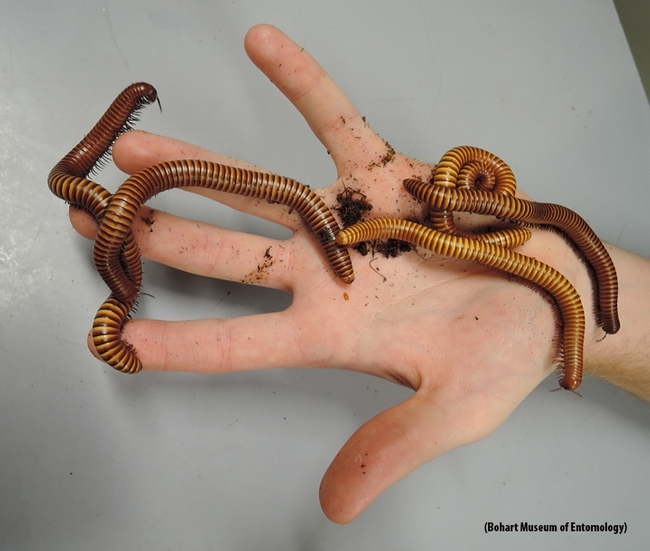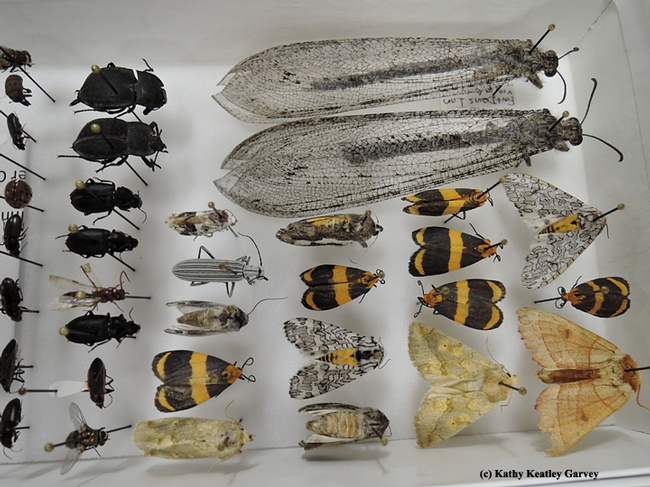- Author: Kathy Keatley Garvey

That includes spiders. You've seen those adorable jumping spiders with green "fangs" (chelicerae), right? But have you even seen the green lynx spiders?
A few years ago we spotted a green lynx spider, Peucetia viridans, on a pink rockrose blossom. Arachnologists tell us it's usually found on green plants--green on green--which is exactly why we can't find it!
Meanwhile, want to see and learn about spiders?
Then you'll want to attend the Bohart Museum of Entomology open house, themed "Many Legged Wonders," from 1 to 4 p.m., Saturday, March 18 in Room 1124 of the Academic Surge Building, 455 Crocker Lane. Yes, it's free. So is parking. And yes, it's family friendly. The family arts-and-crafts activity, coordinated by UC Davis doctoral candidate Emma Jochim, of the Jason Bond arachnology lab will be working with model clay to mold arachnids and myriapods.
Jochim and fellow doctoral candidate Xavier Zahnle of the Bond lab will answer your questions about spiders from 1 to 1:30. First-year graduate student Iris Quayle of the Bond lab will moderate the session. Lab members also will show some "rarer live arachnids such as 'vinegaroons' and 'whip spiders' in addition to tarantulas and scorpions," Jochim said. "We will also have millipedes that people can handle and many species of isopods."
A showing of live animals and specimens is scheduled from 1:30 to 4 p.m. Elijah Shih, a third-year UC Davis transfer student who plans to pursue a career in veterinary medicine, will show his isopods. Bohart Museum research associate Brittany Kohler, the "zookeeper" of the Bohart petting zoo, will show the current tenants, which include tarantulas, black widows, a brown widow, a centipede, Madagascar hissing cockroaches, stick insects and ironclad beetles.
Of course, the tarantulas sport such endearing names as "Princess Herbert," "Peaches" and "Coco McFluffin." Much better than "Killer," "Fang" or "Monster Man."
The Bohart Museum, part of the UC Davis Department of Entomology and Nematology, is directed by UC Davis distinguished professor Lynn Kimsey. It houses a global collection of eight million insect specimens, plus the live petting zoo, and a gift shop stocked with insect-themed books, posters, jewelry, t-shirts, hoodies and more. The Bohart Museum was founded in 1946 and named for UC Davis professor and noted entomologist Richard Bohart.
The Bohart Museum, dedicated to "understanding, documenting and communicating terrestrial arthropod diversity," is open to the public Mondays through Thursdays, from 8 a.m. to noon, and 1 to 5 p.m. More information is available on the Bohart website at https://bohart.ucdavis.edu or by emailing bmuseum@ucdavis.edu.
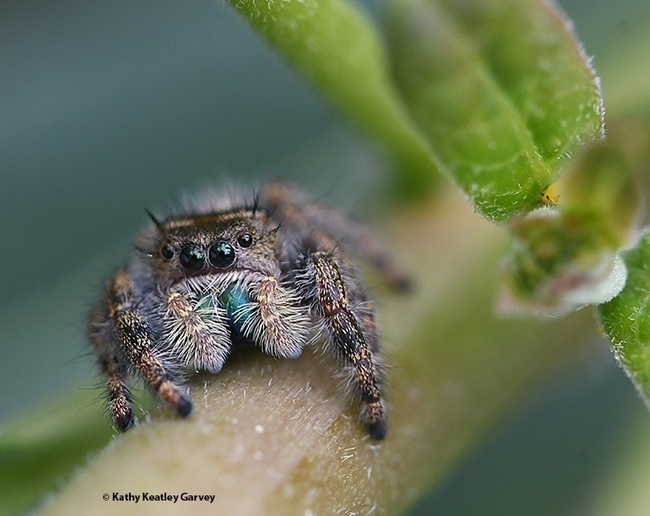
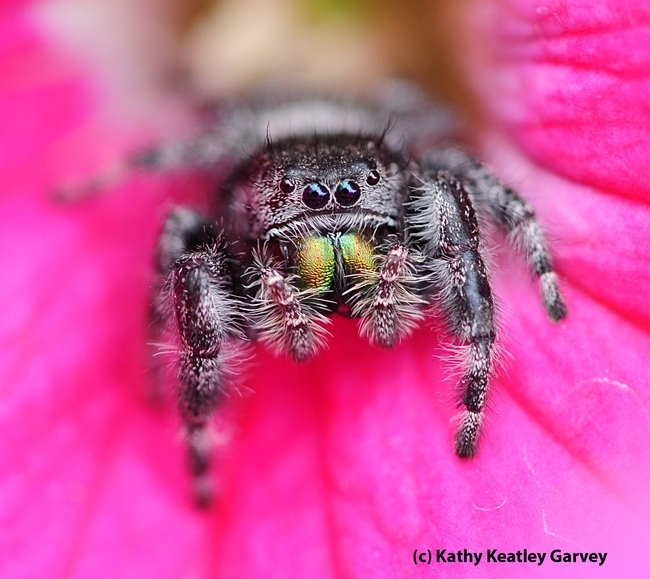

- Author: Kathy Keatley Garvey

If you said "14," go to the head of the class.
Is it an insect? No, it's a crustacean.
When the Bohart Museum of Entomology hosts an open house on "Many-Legged Wonders" from 1 to 4 p.m., Saturday, March 18, among the critters showcased will be spiders, millipedes, centipedes, scorpions, tarantulas, and yes, isopods.
The event, free and family friendly, takes place in Room 1124 of the Academic Surge Building, 455 Crocker Lane, UC Davis campus.
Elijah Shih, a third-year UC Davis transfer student studying neurobiology, physiology and behavior, will show his isopods. “Isopods come in many morphs and sizes," he says. "There are many colorful and beautifully patterned isopods, some natural, some man made. Isopods are crustaceans and require moisture to breathe and molt properly. Some species have the ability to conglobate or roll up in to the ball where as others do not. They are great for helping create a bioactive system for reptiles, planted tanks, and a great feeder for young reptiles and amphibians.”
“There are many isopod species in the world," Shih related, “and at least five common isopod species that are found in California: Porcellio laevis, Porcellio scaber, Armadillidium vulgare, Porcellio dilatatus, and Cubaris marina. Their morphs are considered wild type.”
Shih, who hopes to pursue a career in veterinary medicine, said he houses “many reptiles, both aquatic and terrestrial, such as the box turtle and gargoyle gecko. I wanted to create bioactive environments for my reptiles—(mainly to not have to pick up the feces)-- so I looked for ways to make that possible. I need something that was small, agile, prolific, and safe to be eaten. Isopods, better known as Rollie pillows or pill bugs, are the best solution for me. I had my isopods, but to complete the cleanup crew, I added springtails to help clean up any leftover food, but more importantly, the mold.”
Tabatha Yang, education and outreach coordinator for the Bohart, announced that doctoral candidates Emma Jochim and Xavier Zahnle of the Jason Bond arachnology lab will dispel myths about spiders and millipedes at a question-and-answer session from 1 to 1:30. Doctoral student Iris Quayle will moderate.
From 1:30 to 4 p.m., will be the general open house with a showing of live animals and specimens. Bohart Museum research associate Brittany Kohler, the "zookeeper" of the Bohart petting zoo, says the current residents include:
- Princess Herbert, a Brazilian salmon-pink bird-eating tarantula (Lasiodora parahybana), age estimated to be around 20 (current oldest resident)
- Peaches, a Chilean rose hair tarantula (Grammostola rosea)
- Coco McFluffin, a Chaco golden knee tarantula (Grammostola pulchripes)
- Beatrice, a Vietnamese centipede (Scolopendra subspinipes), newest resident
- Two black widows (Latrodectus hesperus)
- One brown widow (Latrodectus geometricus)
Among the other residents are Madagascar hissing cockroaches, a giant cave cockroach, stick insects, a bark scorpion and ironclad beetles. A family arts-and-crafts activity is also planned.
The Bohart Museum, directed by UC Davis distinguished professor Lynn Kimsey, houses a global collection of eight million insect specimens, plus the petting zoo and a gift shop stocked with insect-themed books, posters, jewelry, t-shirts, hoodies and more. Dedicated to "understanding, documenting and communicating terrestrial arthropod diversity," the Bohart Museum was founded in 1946 and named for UC Davis professor and noted entomologist Richard Bohart. The insect museum is open to the public Mondays through Thursdays, from 8 a.m. to noon, and 1 to 5 p.m.
More information is available on the Bohart website at https://bohart.ucdavis.edu or by emailing bmuseum@ucdavis.edu.


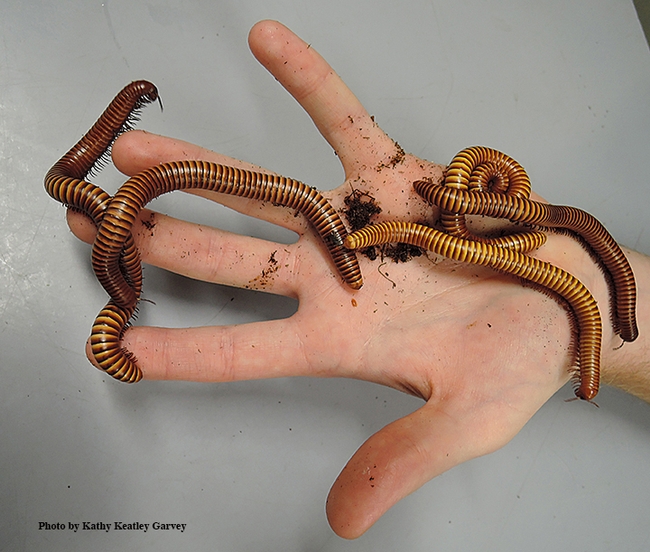
- Author: Kathy Keatley Garvey
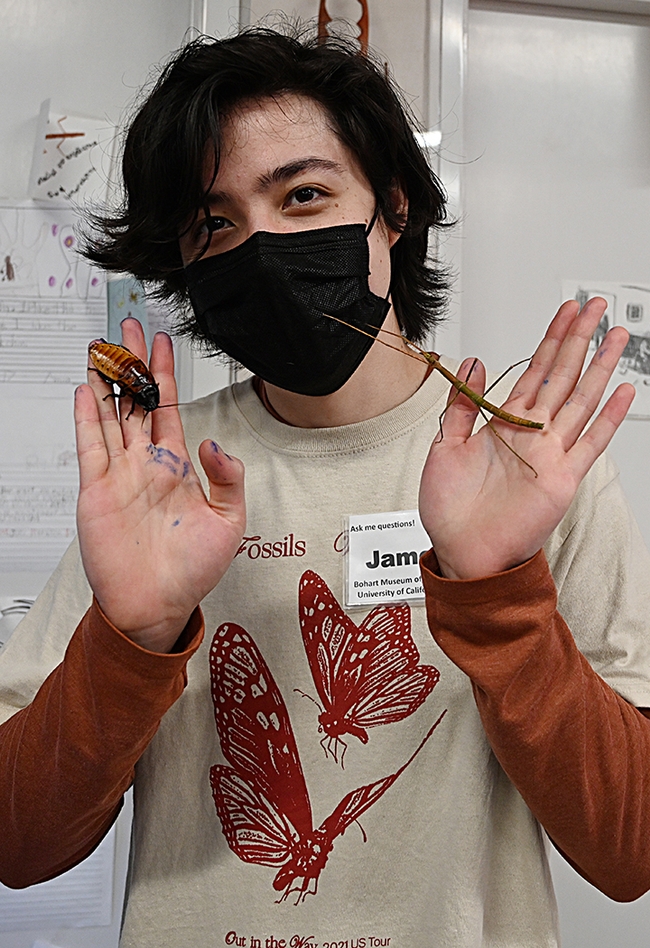
Or "B" is for Biodiversity Museum Day.
You, no doubt, saw the stick insects, Madagascar hissing cockroaches and millipedes. And you may have handled them. Scores of children--and many adults--asked to touch or hold them.
The Bohart Museum, directed by Lynn Kimsey, UC Davis distinguished professor of entomology, shared a booth at the Conference Center with the laboratory of Jason Bond, who is the Evert and Marion Schlinger Endowed Chair in Insect Systematics, UC Davis Department of Entomology and Nematology, and associate dean, College of Agricultural and Environmental Sciences. Arthropods from the Bond lab also included a scorpion and a trapdoor spider. The Bohart displayed a number of specimens, including the state insect, the California dogface butterfly, and the Asian giant hornet (nicknamed "murder hornet" by the news media.)
Some 1300 visitors checked out the displays, staffed by scientists from 11 museums or collections on campus:
- Arboretum and Public Garden
- UC Davis Bee Haven
- Bohart Museum of Entomology
- Botanical Conservatory
- California Raptor Center
- Center for Plant Diversity
- Department of Anthropology Museum
- Museum of Wildlife and Fish Biology
- Nematode Collection
- Paleontology Collection
- Phaff Yeast Culture Collection
This was the first year the free, science-based event has been held exposition-style in one facility. A special feature: side trips to several of the museums or collections.
Senior museum scientist Steve Heydon periodically escorted tours from the Conference Center to the Bohart Museum located in Room 1124 of the Academic Surge Building. Currently closed to the public due to COVID-19 pandemic precautions, the Bohart houses a global collection of eight million insect specimens, plus a live "petting zoo" (Madagascar hissing cockroaches, stick insects and tarantulas) and an insect-themed gift shop (now online).
(Editor's Note: More coverage pending)
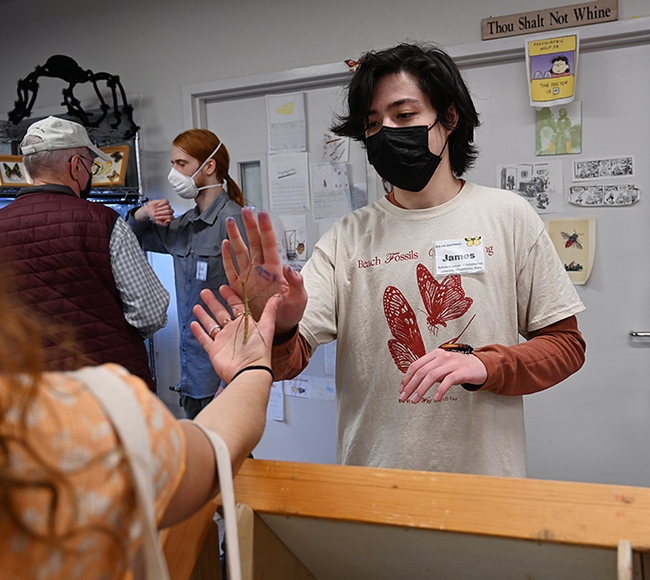
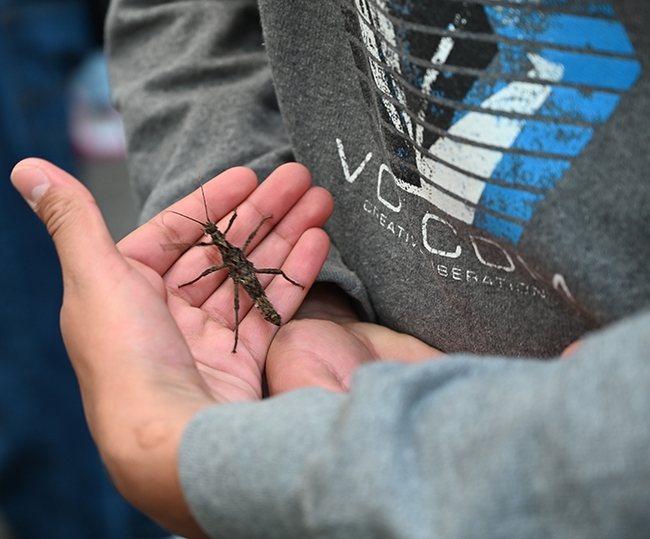
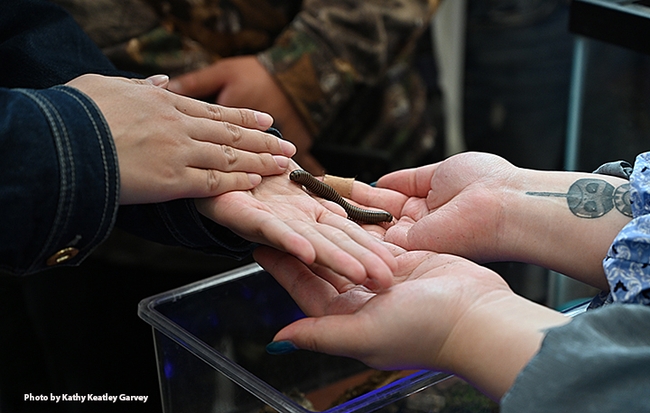
- Author: Kathy Keatley Garvey
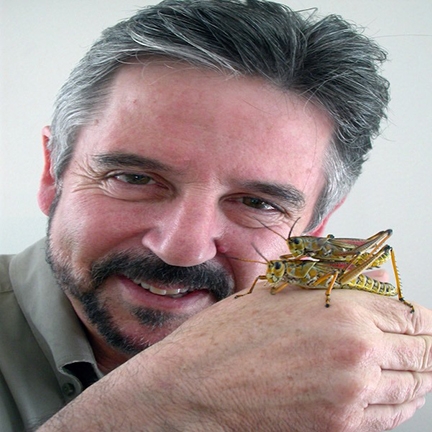
If you'd like to take a world tour and learn about such fascinating insects as darkling beetles, Australian walking sticks, giant African millipedes and others, be sure to sign up for the "Virtual Insect Palooza with the Insect Discovery Lab."
The program, open to all ages but limited to 25 participants, is set for 4 to 5 p.m., Friday, June 12 on Zoom, announced Norm Gershenz, chief executive officer and co-founder of the Bay Area-based SaveNature.Org. He also directs the organization's Insect Discovery Lab. He co-founded SaveNature.Org with wife Leslie Saul-Gershenz, a UC Davis scientist who holds a doctorate in entomology from the UC Davis Department of Entomology and Nematology.
"Professor Norm" will lead what is being billed as a "live, wild experience featuring arthropods from around the world." Viewers will be able to ask questions at the end of the program.
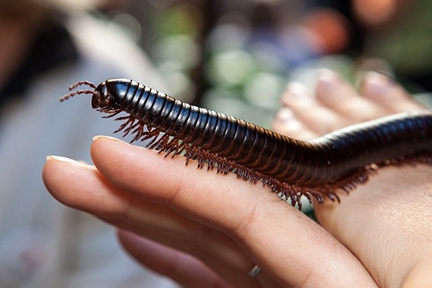
SaveNature.Org is an award-winning conservation organization which presents more than 800 educational outreach programs to some 38,000 children annually. National Geographic, Time magazine, and ABC's "World News Tonight" have all spotlighted the work.
Dedicated to international conservation, SaveNature.Org has raised more than $4.7 million to help preserve thousands of acres of rain forest, coral reef and desert habitat around the world, said Gershenz, who created and developed the first Adopt-an-Acre program in the United States, as well as the award-winning Conservation Parking Meter.
His credentials include 18 years with the San Francisco Zoo as an educator, member of the animal care staff, fundraiser, and researcher. In addition, he has worked as a field biologist and naturalist in Borneo, Malaysia, India, Nepal, Costa Rica and Namibia. "I have tracked black rhinos in Zimbabwe, chased orangutans in Borneo, and stalked the elusive platypus in Australia (with his camera)," he related. In his conservation work, he has handled boas and bobcats, pandas and elephants, snow leopards and koalas, hippos and hornbills.
In 2010, Gershenz received the prestigious Elizabeth Terwilliger Prize for Conservation. In 2018 the American Association of Zookeepers presented him with the Lifetime Achievement Award for outstanding work in nature conservation.
Resources:
SaveNature.Org website
SaveNature.Org Facebook
YouTube Video of Insect Discovery Lab
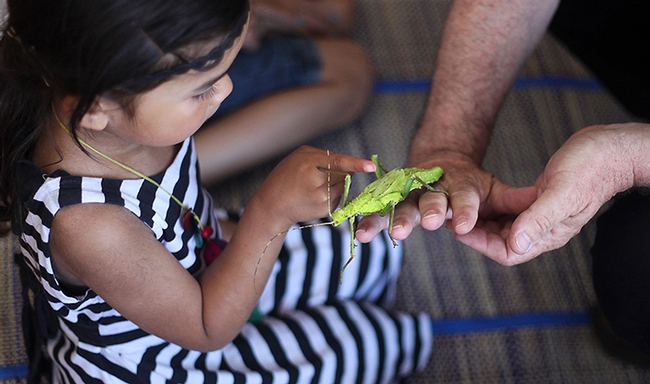
- Author: Kathy Keatley Garvey
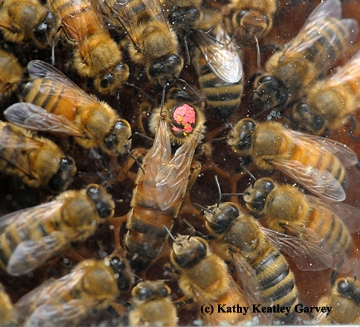
Mark your calendar.
The Bohart Museum of Entomology on the UC Davis campus is planning an open house on "How to Be an Entomologist" from 1 to 4 p.m., Saturday, Sept. 27. The insect museum is located in Room 1124 of the Academic Surge building, Crocker Lane, off LaRue Road.
The event is free and open to the public and is family friendly. This is the first of nine open houses during the 2014-15 academic year.
Plans call for a number of UC Davis entomologists to participate--to show and explain their work, said Bohart Museum director Lynn Kimsey, professor of entomology, UC Davis Department of Entomology and Nematology.
"We will have a pinning and butterfly and moth spreading ongoing workshop with Jeff Smith and tips on how to rear insects," said Tabatha Yang, the Bohart Museum's education and outreach coordinator. Smith, an entomologist in Sacramento, is a longtime donor and volunteer at the Bohart.
Representatives from the labs of molecular geneticist Joanna Chiu, assistant professor; bee scientist Brian Johnson, assistant professor; ant specialist Phil Ward, professor; insect demographer James R. Carey, distinguished professor; and integrated pest management specialist Frank Zalom, distinguished professor and current president of the 7000-member Entomological Society of America will share their research.
The Johnson lab will provide a bee observation hive, and Cindy Preto of the Zalom lab will be sharing her research on leafhoppers. The Carey lab will show student-produced videos, including how to make an insect collection, and one-minute entomology presentations (students showcasing an insect in one minute). The Ward lab will be involved in outside activities, demonstrating how to collect ants. Entomology students will be on hand to show visitors how to use collecting devices, including nets, pitfall traps and yellow pans.
Other entomologists may also participate. "There will be a lot going on inside the Bohart and outside the Bohart," Yang said. "It will be very hands-on."
The Bohart Museum, founded by noted entomologist Richard M. Bohart (1913-2007), houses a global collection of nearly eight million specimens and boasts the seventh largest insect collection in North America. It also houses the California Insect Survey, a storehouse of the insect biodiversity. The Bohart Museum's regular hours are from 9 a.m. to noon and 1 to 5 p.m. Mondays through Thursdays. The museum is closed to the public on Fridays and on major holidays. Admission is free.
The museum's gift shop (on location and online) includes T-shirts, sweatshirts, books, jewelry, insect-collecting equipment and insect-themed candy.
Special attractions include a “live” petting zoo, featuring Madagascar hissing cockroaches, walking sticks and tarantulas. Visitors are invited to hold the insects and photograph them. The newest residents of the petting zoo are Texas Gold-Banded millipedes, Orthoporus ornatus, which are native to many of the southwestern United States, including Texas.
“They're a great addition to the museum's petting zoo,” Kimsey said. “They are very gentle and great for demonstrations of how millipedes walk and how they differ from centipedes.”
Millipede enthusiast Evan White, who does design and communications for the Robert Mondavi Institute for Wine and Food Science, and is a frequent presenter at the Bohart's open houses, recently obtained the arthropods from a collector in Texas. “Texas Gold-Banded millipedes are naive to many of the Southwestern United States, not just Texas,” he said.
Contrary to popular belief, millipedes are not dangerous. “There is much public confusion about the difference between millipedes and centipedes--not because the two look similar, but because the terms are used interchangeably when not connected to a visual,” White said.
He described millipedes as non-venomous, and relatively slow moving, with cylindrical bodies, two pairs of legs per body segment, and herbivorous. “In fact, they are more like decomposers – they do well on rotting vegetation, wood, etc.--the scientific word for is ‘detritivore.' Most millipedes are toxic if consumed, some even secrete a type of cyanide when distressed. The point being: don't lick one.”
In contract, centipedes are venomous, fast-moving insects with large, formidable fangs, and one pair of legs per body segment. “They are highly carnivorous, although some will eat bananas. Go figure. And they are often high-strung and aggressive if provoked.”

